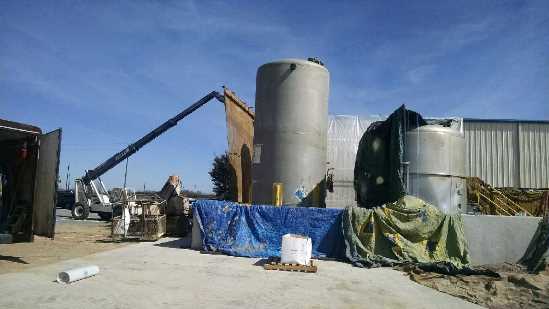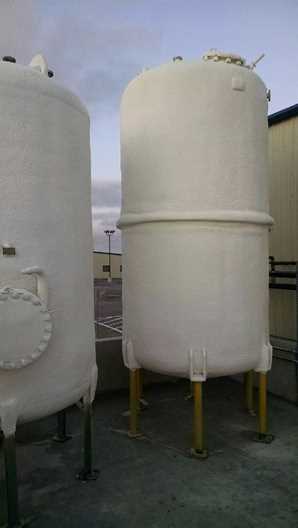Based in Waller, Texas, near Houston, Flowchem LLC is a leading supplier of drag-reducing additives (DRAs) for pipelines. These DRAs are chemicals injected to reduce friction near pipeline walls, and given their flammable nature and importance, proper storage and insulation at the primary manufacturing plant is a must.
So when Flowchem decided to expand and upgrade its plant in 2017, they needed a proven contractor they could trust to insulate three stainless steel (SS) product tanks and one plastic water tank at their home base — all while matching the exterior appearance to other white tanks at the facility. Fortunately for them, nearby spray polyurethane foam (SPF) system installer, Foam Kote, Inc., was up for the challenge.
“All their other tanks were white, and they wanted them to match,” said Archie Umberger, president of Foam Kote and on-site lead for the Flowchem project. “They’re pretty picky. This was a new facility with all-new tanks, and they wanted it done just right.”
Established 45 years ago, Houston-based Foam Kote is a father-and-sons owned and operated company specializing in commercial, industrial, and residential insulating and roofing. Butch Umberger and his two sons, Archie and Cyrus, run the business, along with Butch’s business partner. All three family members worked together on the Flowchem project.
“We’ve been in business since ’73, and I’ve been spraying foam for 18 years. We know what we’re doing, I guess,” Archie said with a chuckle.
Weathering Concerns
The client wanted its tanks insulated and coated as soon as possible, thus allowing other crews to run new piping to the tanks. But the notoriously fickle and unpredictable climate of swampy Southeast Texas wasn’t cooperating, particularly in the cooler winter months.
“If you want it to cure quickly, this wasn’t the right time of year to be doing it,” Umberger said. “If it was hotter out, like 80 °F or 90 °F [26.6 °C or 32.2 °C] weather, it’d be a lot better. But they were trying to get the plant up and going, so they needed them insulated right then.”
The wind blew 15 to 25 mph (24.1‒40.2 km/h) each day, leading to significant overspray concerns. Cars had to be moved from the company’s parking lot, but in addition to that, a newly constructed building was located just 6 feet (1.8 m) from the tanks.
“I told them not to put [the tanks] right up next to the building,” Umberger said. “That’s why it took us so long. If it had been out in the field where they’re supposed to be, it wouldn’t have been a problem. But they set them up right next to the building.”
Secondary containment structures and a new commercial air conditioning system were just a few feet away, as well. As a result, the crew draped concrete, valves, and the entire exterior of the building with plastic to protect from overspray. That extensive preparation process took several days, the Foam Kote crew recalled.

“The problem on this job was a lot of wind, so we had to drape everything,” Umberger explained. “We used big burlap all the way around the tanks to contain them, held down with a few hundred pounds of wood on the ground. Then we draped the ground of the building, and then all the valves and piping.”
Moisture on the substrate, which would have prevented proper curing, was also a problem. Occasional rain showers hit the jobsite on the first week of the three-week assignment, and even when it was dry, dew typically would not dry off the tanks until after the midday sun hit them.
As a result, even though the client needed the job finished quickly, the actual application windows for the SPF and elastomeric protective coating system were fairly limited.
Insulating the Tanks
Accessing the 23-foot-tall (7.0 m) tanks was a hurdle in itself, requiring the use of a 40-foot (12.2 m) JLG boom lift for the three crew members. Before getting on the lift each day, each crew member wore a harness and lanyard from Miller Fall Protection, a respirator from 3M, and long-sleeved clothing, head gear, and face shields as personal protective equipment (PPE) to ensure their safety.
The crew first cleaned the entire substrate with 4,000 psi (27.6 MPa) pressure washers before allowing it to dry. They also primed and prepped all 2,340 square feet (217.4 m²) of the tanks. To prime, they used a direct-to-metal (DTM) stainless steel wash primer.
“We used the DTM primer due to the stainless steel,” Umberger said. “The primer cures in an hour and a half to two hours, and then you can apply your foam.”
 Once primed, the crew applied Lapolla’s 2.8 lb. (1.3 kg) SPF using a Graco H-40 proportioner. Working in sections, the crew laid the SPF down in a 2-inch (5.1 cm) layer on all three SS tanks and the plastic water tank.
Once primed, the crew applied Lapolla’s 2.8 lb. (1.3 kg) SPF using a Graco H-40 proportioner. Working in sections, the crew laid the SPF down in a 2-inch (5.1 cm) layer on all three SS tanks and the plastic water tank.
To finish each section, the team applied two coats of Lapolla’s Thermo-Flex acrylic elastomeric protective coating to all of the tanks, utilizing a Graco Extreme King 45:1 airless pump. The first coat was a tan basecoat and the next was bright white, thus allowing crew members to know where they had applied both coats and ensure complete coverage.
The goal was to apply the basecoat on the same day as the SPF, which cured quickly, and then allow the basecoat to cure overnight before applying the white topcoat. However, the weather conditions did not always allow for optimal efficiency.
“Everything was weather permitting,” Umberger said. “We couldn’t work when it was too wet, and in the mornings it was too cold. We had to wait each day for it to heat up. The surface temperature with foam needs to be right at 70 °F [21.1 °C], or else it’ll crack off. So we tried to get the foam and the basecoat applied on the same day, but sometimes we didn’t have time.” If the basecoat could not be applied until the following day, the crew would apply it the next morning, give it almost a full day to cure, and move onto a different section in the interim.
In all, the combined dry film thickness (DFT) of the two coats on all the tanks was ~35 mils (889.0 microns).
Sealing up Success
Despite the weather-related hurdles, the three-man Foam Kote crew finished the entire job within three weeks — thus allowing the rest of Flowchem’s project schedule to remain on course. This enabled the plant to begin operations by the spring.
Thanks to the work of Umberger’s team, pipeline efficiency is one step closer to reality for Flowchem’s long list of industry clients. It’s safe to say this crew was anything but a drag!